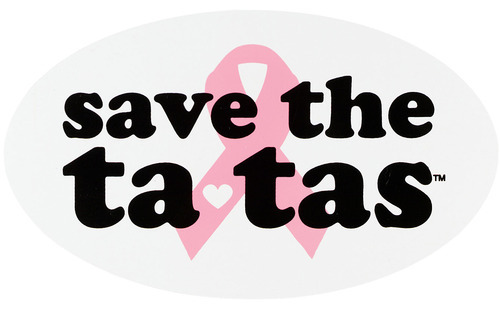 Graphic of a pink ribbon with the text 'save the ta tas'
Graphic of a pink ribbon with the text 'save the ta tas'
Not So Pretty in Pink
One young woman takes on pink ribbons and the “pinkwashing” industry during Breast Cancer Awareness Month
By Amanda Vodola
One night in May 2012, I was lying in my bed in my Brooklyn apartment, tossing and turning because it felt like I pulled my pectoral muscle. It was uncomfortable, and, after a breast exam, I found a distinct lump in my right breast. I did some research the next morning and called my mom to let her know. “It’s probably nothing,” I assured her. I read a few websites and determined that it was likely a benign clump of cells (breast fibroadenomas) or a cyst that could be easily drained. After some arguing, my mom insisted I return home to Connecticut to see a doctor there.
In the following months, I turned 23, met several doctors, received multiple breast exams, had my first mammogram and a few ultrasounds. I was commuting from New York to Connecticut constantly, so my thinking and decision-making were along the lines of “What can I squeeze into a day so I can go back to New York?” I wasn’t very concerned; the chances of breast cancer in your 20s is 1 in 1,800 – that’s approximately a .0006% chance.
My doctors reassured me that it was most likely nothing, but I decided to get a biopsy so I could put this thing to rest and move on. In October, a few days after my biopsy, I was diagnosed with Ductal Carcinoma In Situ (DCIS) – a non-invasive breast cancer, commonly known as “Stage 0.” It’s been a year of intense reflection, and now that it’s Breast Cancer Awareness Month, I think it’s important for me to share my experience.
Before I continue, I think it’s important for me to note that I don’t speak on behalf of everyone with DCIS or invasive breast cancer. There are people who may disagree with what I have to say on the subject, but I know there are other folks who struggle to cope with diagnosis and treatment – I know there are other people who would like to heal sans pink ribbons. I think the worst thing I could do this month would be to remain silent.
After I was diagnosed, my doctors repeatedly told me that it’s not really cancer, but they couldn’t tell me how it happened, or why DCIS – which doesn’t normally appear in lumps – grew inside the lump in my breast. I chose to get a partial mastectomy to remove the cancerous cells, and then proceed with radiation and oncology treatment.
As someone who struggles with depression, my diagnosis weighed me down further, but I went out every night to surround myself with friends and self-medicate: I wanted to assure others that I was fine. In The Cancer Journals, Audre Lorde identifies the moment of diagnosis as “becoming forcibly and essentially aware of my mortality.” I went through bouts of euphoria, like being diagnosed with DCIS was a chance to change my life drastically, like heroes do in movies. Then there were moments when getting out of bed was impossible, and I would lie there and berate myself for not appreciating life enough, for failing to do anything of value, for having it better than “real” breast cancer survivors and those who died from the disease. I often ruminated, “You’re not dying,” but this provided little comfort.
In order to stay in New York, I worked an average of 35-40 hours a week while going through radiation treatment for three weeks in December. Treatment was five days a week, and I felt drained by both the commute to New York University’s Cancer Institute and the specific kind of loneliness that shook me in the waiting room, where I was surrounded by older women who looked at me with pity. I felt guilty for being there and drawing their attention because I wasn’t dying. I went on long walks after my morning appointments, and I didn’t drink for those three weeks – I thought I had it all figured out. I thought everything would go back to normal after, to a life where my next challenge was getting my foot in the door toward a career path, and that this whole thing was merely a wake-up call.
At the end of January, I started taking Tamoxifen. Like many people who take Tamoxifen, I’m fairly confident I got every listed side effect and then some. The first month was the worst – I was walking in a fog, feeling detached from my body, unable to focus on simple tasks. It multiplied my depression and fatigue, I gained twenty pounds, I kept forgetting the names of my friends and coworkers, and sometimes I couldn’t leave my room without feeling anxious. The part I hated most were the really strong bouts of rage, moments when I would lash out despite how little it made sense, even to myself. These side effects are less frequent now, thankfully, but there are good days and bad days. Unfortunately, putting up with these side effects is my only option. When I met with my oncologist after the first month, she told me that the alternatives to Tamoxifen have been proven less effective; since then, the only accommodation my oncologist provided was taking it for three years instead of five.
After the first two weeks on Tamoxifen, my depression became unbearable to the point that I was unable to complete expected tasks, as simple as showing up to work on time or meeting with a friend. I was also overwhelmed by my financial situation and the pressure to start a “career.” My mother, a teacher, has a health insurance plan that covers my medical expenses until I’m 26. I’m extremely fortunate for this, but I could hardly afford the copays that amounted to over $200. I was starting to shut out most of my life and responsibilities. Then I was angry, angry that October was full of hope and bright pink, yet everyone failed to mention that my life would not go back to normal, that Tamoxifen is basically menopause in a pill. The best thing I did in the new year was rent Pink Ribbons, Inc. – a documentary on Breast Cancer Awareness Month, specifically focusing on the pink ribbon. It validated my anger and frustration toward pinkwashing, and I found it extremely empowering to see so many people speaking out.
I highly recommend people watch Pink Ribbons, Inc. to understand the effects of pinkwashing. The film depicts the media hype surrounding the pink ribbon, while revealing the silencing of alternative and preventative treatments and research. There is a great amount of hypocrisy when it comes to pinkwashing, since the big corporate sponsors of breast cancer fundraising events are often the environmental hazards that put people at risk. Companies paint their products pink to have people look the other way, and it works – Estée Lauder, Revlon, and Avon are three of the biggest cosmetics companies who use the pink ribbon and host events in honor of breast cancer awareness, but continue to use carcinogens in their products. I know people have good intentions when they don a pink ribbon, but people rarely realize that the symbol originated from a corporate-sponsored study group asked to pick a color that made them think “happy”. The result was pink. There is nothing happy about breast cancer, and someone wearing a ribbon does not provide the support I want or need.
Since breast cancer primarily affects those who are female-assigned, the disease has become sexualized as well as pinkwashed. The correlation between cosmetic company profit and the constant focus on altering the female body cannot and should not be ignored. There is a certain ease with which people can talk about pink ribbons that, at least personally, seems to erase or invalidate the ugly aspects of treatment and surviving. I can’t even begin to articulate my rage when I see “Save the Boobies” and “Save the Tatas” printed on t-shirts and bracelets, as if sexualizing a disease is the only way to make people – in this case, the target market of straight men – care that female-assigned people are dying from cancer. What many people do not realize is that when an area of the body undergoes radiation treatment, it cannot be treated again with radiation if cancer returns in that same area. My doctor told me this information before I agreed to the radiation treatment, and it was a terrifying thing to consider. My entire right breast has been treated in order to prevent a recurrence of DCIS or invasive breast cancer, but if it does recur, my best option will be a mastectomy. Not all breast cancer survivors survive with their breasts. My breasts are a part of me, and I am the one who should have the strongest opinion about them. I deserve bodily autonomy, and I deserve to make decisions without being told to “save the tatas,” without feeling ugly, without feeling as if I failed if I do get a mastectomy some day. I think every breast cancer survivor deserves this right.
Whether or not people decide to get reconstructive surgery or wear a prosthesis is another issue that is inseparable from the social constructs that force many female-assigned people into being attractive for others. Perhaps one of the most empowering moments in all of this was reading Audre Lorde’s The Cancer Journals. Her reflections on beauty post-mastectomy validated many of my concerns. Forever a fierce warrior, Lorde refused to wear her prosthesis after a mastectomy, and it didn’t take long before a nurse told her that it brought down morale in the office. This assumption of reconstruction and prosthesis needs to be deconstructed and discussed. Lorde argues that reconstruction and prosthesis are socially acceptable because survivors are encouraged to pretend, mostly on others’ behalf, that everything is “the same as before.” Not only is reconstruction risky in that cancerous cells may be present in the saved tissue, but there is a longer recovery process. It’s horrifying to think that survivors struggle with the weight of these decisions and the healing process so often in silence. Lorde illustrates great concerns of what it means to be feminine and beautiful, and what can be done to explore post-mastectomy alternatives to reconstruction.
I’ve read so much in order to try and put my depression in context of what this month means to me and to others. There are good days and there are bad days; there are brave days and there are days when I feel like a coward. I don’t have a solution, but no solution can be found by remaining silent. I encourage people to research Tamoxifen and treatments, to read The Cancer Journals, to watch Pink Ribbons, Inc., but mostly, if you know anyone who has been diagnosed with breast cancer, I encourage you to listen, not just this month, but always.

